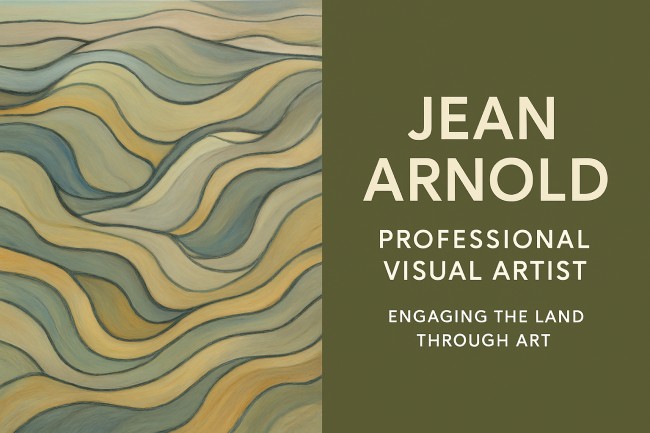Jean Arnold: A Visionary Professional Visual Artist Engaging the Land Through Art

Jean Arnold stands as an influential figure in contemporary American art, a professional visual artist whose work explores the deep and often complex relationship between humans and the natural environment. Residing in Lewiston, Idaho, Arnold has dedicated over six decades to honing her craft and developing a unique artistic voice that combines abstraction with observation. Through her paintings, mixed media paperworks, and books, she brings a biomorphic sensibility inspired by the rolling hills of the Palouse region. This landscape has shaped her artistic perspective from a young age.
This article delves into the life, education, and artistic career of Jean Arnold, highlighting her remarkable journey as a professional visual artist and the critical themes that animate her work. It aims to provide an informative and engaging overview designed to rank highly in search engines and offer a comprehensive understanding of her contributions to the art world.
Early Life and Artistic Inspiration
Born and raised in the Pacific Northwest’s Palouse region, Jean Arnold’s formative years were marked by an intimate connection to the natural contours and shapes of the land. The Palouse is known for its sweeping rolling hills, unique sinuous contours, and a rich agricultural history, all of which have profoundly influenced Arnold’s artistic sensibility. Her early exposure to this landscape instilled in her a deep appreciation for the interplay between nature and human activity—a theme that remains central to her work today.
Arnold’s art transcends simple representation; instead, she embraces a biomorphic approach that abstracts from direct observation, enabling her to express the invisible forces and dynamic processes that shape the environment. This fusion of abstraction and observation allows her to convey both the beauty and fragility of the land, making her work resonate on multiple levels with audiences.
Professional Visual Artist: A Lifelong Commitment
Jean Arnold’s professional career spans more than 60 years, reflecting an extraordinary commitment to the visual arts. Her oeuvre includes a broad spectrum of works, ranging from paintings and mixed media paperworks to artist books, each piece carefully crafted to explore ecological and social issues. Arnold’s art is not only aesthetically compelling but also intellectually provocative, urging viewers to reconsider their relationship with the natural world.
Her exhibition history is extensive, featuring numerous solo and group shows across regional and national venues. Notable among these are her 2023 solo exhibition Land Lines at the Lewis Clark Center for Arts and History in Lewiston, Idaho, and a two-person show in 2022 with Ellen Vieth at Moscow Contemporary in Moscow, Idaho. Arnold’s work was also prominently included in the 2021 exhibition Edge of the Abyss at the Missoula Art Museum, a significant show that addressed the environmental devastation caused by mining activities.
In 2008, Arnold’s solo exhibition at the Yellowstone Art Museum in Billings, Montana, further cemented her reputation as an artist deeply engaged with environmental themes. Her paintings often highlight the impact of large-scale human activities such as mining and agriculture on the land, capturing both the scars and resilience of the environment.
Arnold’s art is held in many public, corporate, and private collections, demonstrating her broad appeal and the lasting value of her work. Institutions such as the Missoula Art Museum, Boise Art Museum, and Utah Museum of Fine Arts count her among their notable artists.
Education: A Foundation for Artistic Excellence
Jean Arnold’s formal education laid a robust foundation for her artistic development. She earned her Bachelor of Fine Arts degree, cum laude, in Illustration from Utah State University in 1983. This early training provided her with strong technical skills and an understanding of visual storytelling, which she would later expand upon in her graduate studies.
From 1991 to 1995, Arnold pursued upper-level drawing and painting courses at the University of Utah, Salt Lake City. These postgraduate studies allowed her to deepen her mastery of fine art techniques and further explore thematic concerns related to landscape and abstraction.
The pivotal moment in Arnold’s education came when she earned her Master of Fine Arts degree from Northern Vermont University (previously Johnson State College) in 1999. This MFA program was offered in conjunction with the Vermont Studio Center, a prestigious residency program known for fostering artistic innovation. Arnold attended a total of seven months of residencies split between the Vermont Studio Center and the International School of Art in Italy. The experience of studying in Italy was especially transformative; the Italian landscape and its rich artistic heritage resonated with Arnold’s own visual experiences of the Palouse, reinforcing her commitment to abstraction informed by nature.
During her MFA program, Arnold benefited from the guidance of numerous artistic luminaries, which shaped her approach to art making and conceptual inquiry. This period of intensive study and creative experimentation was crucial in establishing the thematic and stylistic directions that define her work today.
Artistic Themes and Style
Jean Arnold’s artistic practice is deeply rooted in her concern for the environment and the effects of human activity on the land. Her work frequently incorporates themes of ecological degradation, sustainability, and resilience. She uses abstraction to express these themes, often employing organic, flowing shapes and layered textures to evoke the contours of landscapes altered by human intervention.
Her paintings and paperworks often resemble aerial views or topographic maps, inviting viewers to consider not only the visible landscape but also the underlying processes that shape it. This “eagle’s eye view” approach gives her work a unique perspective, allowing her to explore complex environmental narratives within visually compelling compositions.
Arnold’s use of mixed media allows her to experiment with texture and form, adding depth to her works and enhancing their emotional impact. By combining traditional painting techniques with collage and paper manipulation, she creates dynamic surfaces that suggest movement and change—an apt metaphor for the ever-shifting relationship between humans and the Earth.
Exhibitions and Recognition
Jean Arnold’s artistic excellence has been recognized through numerous exhibitions and awards. Her 2023 solo exhibition, Land Lines, showcased drawings and paintings inspired by the Palouse, highlighting how natural and human forces shape the land’s contours.
The 2022 two-person show with Ellen Vieth at Moscow Contemporary offered an exploration of contemporary painting, emphasizing dialogue and contrasts between different artistic approaches.
Arnold’s participation in the 2021 Edge of the Abyss exhibit at the Missoula Art Museum connected her work with a larger national conversation about mining’s environmental impact, a subject she has addressed repeatedly in her art.
She has received several honors, including purchase awards and grants from arts councils, reflecting both her artistic merit and contribution to cultural life. Her work has also been included in collections across the United States, attesting to its significance and appeal.
Also Read> Peter Rubie: Mastering the Art of Production Lighting Design
Conclusion
Jean Arnold exemplifies the power of art to engage deeply with pressing environmental issues while maintaining aesthetic integrity and emotional resonance. Her long and distinguished career as a professional visual artist, supported by rigorous education and rich artistic experience, positions her as an influential figure in contemporary American art.
Through her paintings, paperworks, and exhibitions, Arnold invites us to reconsider how we see and interact with the land—reminding us of our responsibility as stewards of the environment. Her work stands as a testament to the enduring relevance of art in shaping cultural understanding and inspiring change.
As Jean Arnold continues to create and exhibit, her contributions will undoubtedly influence both artists and audiences, fostering greater awareness of the fragile balance between humanity and nature.



